
|
|
July 17-24, 2002
Eiffel Tower and Maison Radio France, Paris
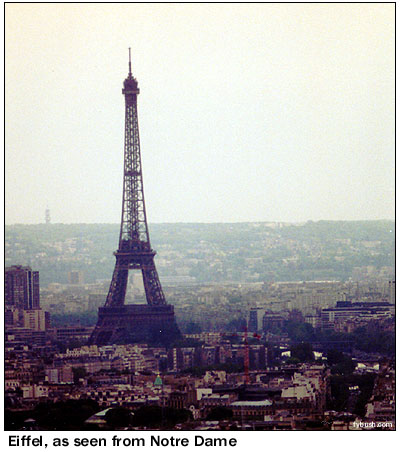 Until
now, all the sites we've presented here at Tower Site of the
Week have had one important thing in common: they've all been
on the same side of the Atlantic Ocean.
Until
now, all the sites we've presented here at Tower Site of the
Week have had one important thing in common: they've all been
on the same side of the Atlantic Ocean.
But in late April and early May of 2002, your editor had the opportunity to spend some time in England and France. And with the kind permission of Mrs. Editor, the vacation even included a few stops at interesting and important tower sites.
"Interesting" and "important" have very different meanings when in the company of non-tower hunters, of course - but there are a few spots in the world where even those with no appreciation for the finer aspects of RF transmission technology can still find themselves fascinated by a radio tower, even if they don't know it.
So it was, on one of the clearer days of an otherwise rainy and damp stay in Paris, that we found ourselves queued up at the base of the Eiffel Tower waiting to pay our euros and ride the elevator all the way up to the top.
By modern standards, of course, Eiffel isn't all that tall - 1,056 feet to the top of the transmission mast, from a base that's actually at one of the lower spots in Paris. And when it was built in 1889 for the International Exposition, wireless transmission of voice or even code was still a thing of the future. Monsieur Eiffel built this tower strictly for show, to mark the main entrance of the exposition!
A few decades after the exposition, though, Parisians were calling for the demolition of the "eyesore" that had been built as a temporary highlight of the fair - and it just might have been torn down, had not the engineers begun to realize that the Eiffel Tower was an ideal spot for all sorts of radio transmissions. The military used the tower for its radio needs during the First World War, and even earlier, American inventor Lee De Forest had made test voice transmissions from its top.
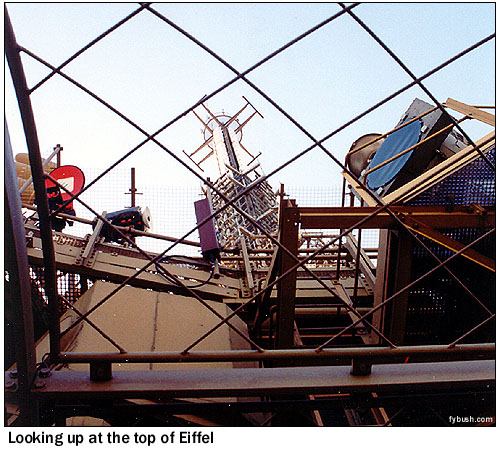 The
tower remained in use after the war, as regular broadcasting
began in France on long- and medium-wave frequencies. Your editor
suspects that those broadcasts were accomplished with vertical
wires strung along the legs of the tower, but with all sorts
of lighted signs and clocks and whatnot also cluttering the tower
in that era, it was probably not an ideal spot for AM transmissions.
The
tower remained in use after the war, as regular broadcasting
began in France on long- and medium-wave frequencies. Your editor
suspects that those broadcasts were accomplished with vertical
wires strung along the legs of the tower, but with all sorts
of lighted signs and clocks and whatnot also cluttering the tower
in that era, it was probably not an ideal spot for AM transmissions.
The advent of television and FM broadcasting in the thirties truly showed off the value of Eiffel, though. Low-resolution TV broadcasts (by today's standards, anyway; the 180-line pictures were considered "high definition" then) began in 1935, and by 1939, Eiffel was sending out 455-line pictures at an unheard-of power of 30 kilowatts, the most powerful TV signal in all of Europe.
The next year brought the war to Paris, putting Eiffel under armed guard and ending television transmission for the duration. TV resumed after the war on the new, uniquely French, standard of 819 lines, and has continued from Eiffel ever since. As early as the late forties, England and France were sending live TV back and forth over the English Channel, with the French signal from Eiffel being received on the English coast at Dover, converted to the British 405-line standard by placing a British camera in front of a French TV set (!) and sent by microwave to the BBC in London.
Like the rest of Europe, France began making the transition from VHF to UHF television in the sixties and seventies, with the 819-line black and white VHF signals giving way to 625-line UHF signals, still from the top of Eiffel to serve most of Paris and vicinity. (VHF television resumed in France in the mid-eighties, with a single channel in each city being used for the "Canal Plus" subscription service.)
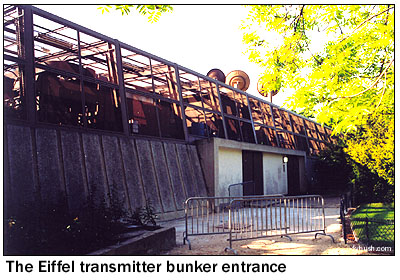 Today,
the top of Eiffel is crowned with transmission facilities for
six analog TV networks (TF1, France 2, France 3, Canal Plus,
France 5/Arte and M6), literally dozens of FM stations (including
the seven services from state-owned Radio France) and experimental
digital radio.
Today,
the top of Eiffel is crowned with transmission facilities for
six analog TV networks (TF1, France 2, France 3, Canal Plus,
France 5/Arte and M6), literally dozens of FM stations (including
the seven services from state-owned Radio France) and experimental
digital radio.
As you can see in the photo above, there are also several layers of electronic newsgathering receivers, two-way transmitters, studio-transmitter link antennas and other assorted RF receivers and transmitters up there above the highest observation deck. During our visit, an engineer was working on one of the ENG receivers - alas, your editor's French wasn't good enough to convey, "Hey, can I get a tour of your plant?"
So where do you put all those transmitters so close to a major national landmark, without disturbing its iconic status? The answer, largely, is "underground": along Avenue Gustave-Eiffel, adjacent to one of the tower's legs, is a long concrete bunker with a big screened area on the roof. The power-handling and HVAC equipment sit on the roof, with the transmitters down below ground level in the bunker. The transmission lines snake their way up one of the tower legs, largely unnoticed by the crowds of tourists making their weary way up or down the stairs.
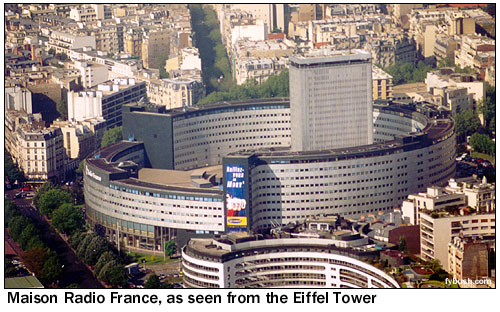 From
Eiffel, you can look across the Seine, past the bridge that's
home to a miniature Statue of Liberty, to the biggest office
building in all of Paris: Maison Radio France, the home to all
the government-owned radio services: France-Inter, France-Culture,
France-Musiques, France-Info, France-Bleu (playing music for
older listeners), FiP (the local service of Radio France), Le
Mouv' (the youth-oriented rock network) and Radio France International.
From
Eiffel, you can look across the Seine, past the bridge that's
home to a miniature Statue of Liberty, to the biggest office
building in all of Paris: Maison Radio France, the home to all
the government-owned radio services: France-Inter, France-Culture,
France-Musiques, France-Info, France-Bleu (playing music for
older listeners), FiP (the local service of Radio France), Le
Mouv' (the youth-oriented rock network) and Radio France International.
All six of the national networks, plus FiP and RFI, are broadcast on FM from Eiffel and hundreds of relay transmitters around France; France-Bleu, FiP and RFI are also available on the AM dial (in RFI's case, with a separate service in languages other than French).
And yes, you can get a tour of the building, provided you can speak some French and provided you can deal with the bureaucracy that is so uniquely French. On the day we tried to visit, the tour schedule available at the front desk bore no relation whatsoever to what the tourist guides had said, so we ended up traveling to Versailles and back before finally getting on the last tour of the afternoon.
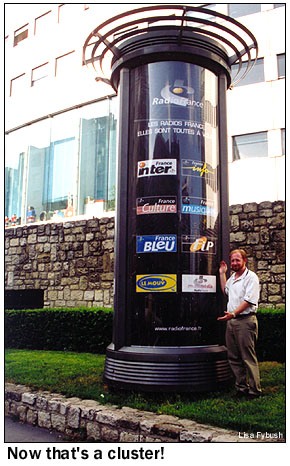 While the tour led
us past the France-Inter studios and into some of the enormous
live performance studios designed for the orchestral performances
on France-Culture, we didn't see most of the actual working space
in this huge building.
While the tour led
us past the France-Inter studios and into some of the enormous
live performance studios designed for the orchestral performances
on France-Culture, we didn't see most of the actual working space
in this huge building.
Instead, our tour guide spent more than an hour guiding us through the Radio France museum, itself a fascinating experience. While the French can't exactly ignore the contributions of Hertz and Marconi to the early development of radio, they prefer to pay attention to a scientist named Edouard Branly. Not a household name, you say? Branly invented the coherer and decoherer, important components of early wireless transmission - and, more to the point, he was French!
In addition to the shrine to Branly, the museum contains a magnificent collection of early radios and radio equipment, including many makes and models rarely encountered on our side of the Atlantic. It's well worth a visit, should you find yourself in Paris with some time to spend playing radio.
And that's about the extent of our contact with French radio; the next day, we were on a train back to London, then a plane back to the U.S., with high hopes for a return visit someday.
We'll get back to our own home turf next week; in the meantime, we're happy to pass along a special offer from our friends at M Street. They've just released the 11th edition of the M Street Radio Directory, the most comprehensive guide to radio in the U.S. and Canada today. Calls, frequency, power, address, key personnel, ownership, ratings - it's all in the nearly 900 pages of the latest edition, and Tower Site of the Week/NorthEast Radio Watch readers can get it at a special discount.
List price on the M Street directory is $79 - but we're pleased to offer it to you for $69, a $10 savings. (You'll also pay $7 for shipping and handling via UPS.) You can order in two ways: by credit card at 1-800-248-4242. Ask for Irene, and tell her you want the "NorthEast Radio Watch" discount. Or, send a check/money order for $76 (payable to Scott Fybush) to 92 Bonnie Brae Avenue, Rochester NY 14618. It's a great resource, and something that should be in the library of anyone who needs to keep track of the radio industry today!
- Previous Site of the Week: Crystal Palace, London, England
- Next Week: Booth Hill (WEDW-TV/WEZN/WSHU/WPKN), Trumbull, CT
- How can you help support Site of the Week? Click here!
- Submit your suggestions for a future Site of the Week!
